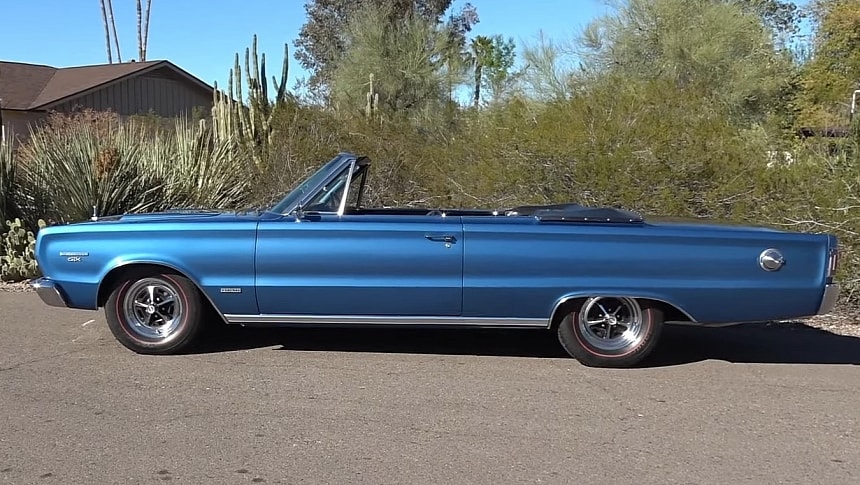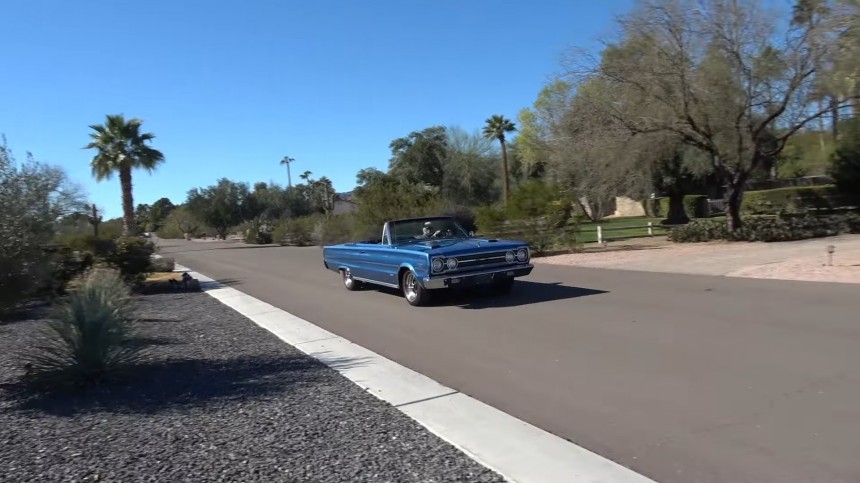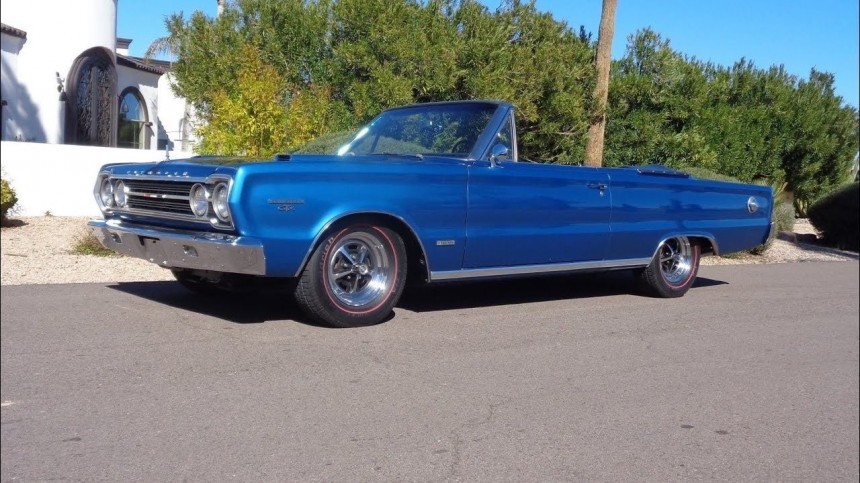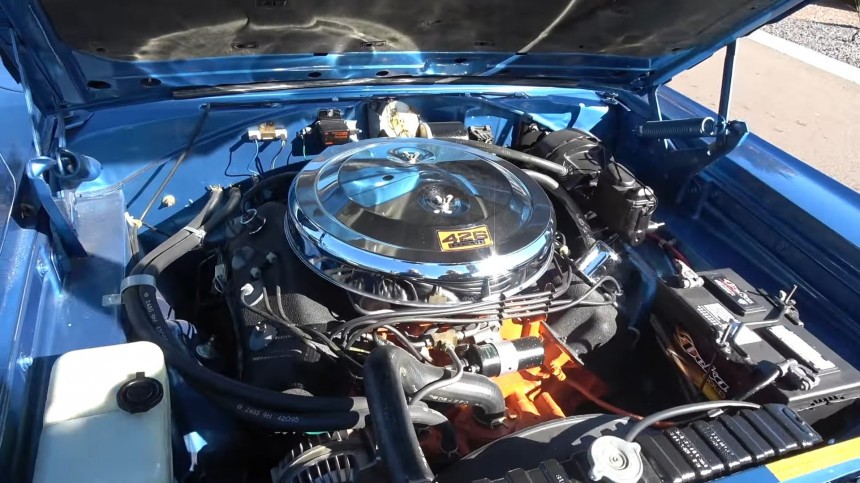By 1965, Detroit was all but hurling the Big Three gentlemen’s agreement to stay out of motorsports into the blazing flames of internal combustion hellfire. Mainly, Ford and Chrysler had something to settle: a squandered dispute from the NASCAR ovals that turned into an all-out war. Horsepower war, that is. In 1966, the smallest of the Big Three put out the biggest cannon in the gunfight: the Street HEMI.
The Charger and the Coronet carried the massive 426-cubic-inch (7.0-liter) engine on behalf of Dodge. At the same time, the Belvedere and the Satellite received that honor for Plymouth. That was 1966, and the following year, Plymouth upped the ante with a two-button suit for the HEMI: the GTX.
It was essentially a pretentious Belvedere, a gentleman’s muscle car with plenty of spoils in the cabin but a scarcity of powertrains. Only two engines were offered with the top-trim Belvedere GTX: the standard equipment was the four-barrel Super Commando 440-cube V8, Plymouth’s 7.2-liter ogre that fires 375 hp (380 PS) and 480 lb-ft (651 Nm).
The extra-costly option was a smaller eight-cylinder plant with quirky combustion chambers shaped like domes. Chrysler called it ‘hemispherical heads,’ and it also called it 425 hp and 490 lb-ft (431 PS, 664 Nm). It was a 564-dollar option for the GTX. It doesn’t sound impressive, but the standard two-door hardtop base price was $3,178 – the engine add-on was 20% over that. The Convertible was a further $240 over the regular solid-roof body ($3,418).
Plymouth planted 737 HEMI wight-cylinder engines in the GTXs of the nameplate’s debut year – 720 had a metal roof, and 17 came with a ragtop (some sources go for an even lower number - 14). Let's go for the more generous estimate of 17. The batch is divided into seven four-speed cars and ten TorqueFlite automatics. Out of just over 12,000 GTX units built for the model year, the HEMI ‘verts are a rarity of unicorn proportions.
One of those more common automatic HEMI GTX convertibles from 1967 (from a vintage of ten examples) is featured in the video below, shot by Lou Costabile in Arizona at the beginning of this month. According to one of its former owners – the one who enjoyed this GTX the longest – the car was resold in 1980 by the original buyer.
Funny enough, an ad in a Cleveland magazine caught a man’s attention (John Ward, the one telling the story over the phone in the video). He and a friend went to see the rare GTX in person. The two men were passionate drag racers and die-hard Mopar fans, so a HEMI was always at the top of their list.
John’s friend ended up taking the cool Mopar home and kept it until 2000. Consequently, he sold it to John Ward, the guy who found the ‘for sale’ ad back in 1980. Around 2019, health issues became a priority for the long-term car nut, and the 1967 GTX drop-top was sold again to its current proprietor.
The odometer reads 73,338 original miles (118,000 km), and the engine was rebuilt meticulously when Mr. Ward took possession of the car 24 years ago. Also, the body was fully refurbished in the early 80s because the Cleveland de-winterization salt treatment had eaten through the metal at some points.
The super rare GTX has the standard 3.23 rear axle with the mandatory Sure-Grip (the HEMI couldn’t be installed all by itself; it had to have some form of traction-dominating device, lest it would fishtail incessantly if the driver put on the lead shoes). One particular thing we can see in the video is the shoulder harness, which might raise an eyebrow or two among those in the know.
The same is valid for the standard round air cleaner instead of the HEMI trade signature dual-snorkel unit. For what it’s worth, note that the two ‘anomalies’ are factory-installed and not restoration mistakes. Despite being advertised as the ‘Fastest way to win you over’ by Plymouth, the GTX was a Belvedere at heart.
Granted, it was the top trim of the mid-size B-body, but a Plymouth nonetheless, and build quality wasn’t the primary concern of Chrysler for its budget division. Performance, yes, but putting an incorrect air cleaner on the HEMI was not the end of the world – particularly for a car with very low build numbers, like the 1967 Plymouth Belvedere GTX convertible with a 426 HEMI in it.
This particular car we see in the video below may be one of the rarest second-generation HEMIs out there. Galen Govier’s Registry states that 13 are documented to exist today, but other sources claim only 10 are left around. Still, this GTX has had a proper life worthy of its name and 426-hemispherical-heads badges (the odometer is solid proof supporting this statement). The mighty V8 rumbles as it was built to do, not just for car shows or Mopar gatherings.
It was essentially a pretentious Belvedere, a gentleman’s muscle car with plenty of spoils in the cabin but a scarcity of powertrains. Only two engines were offered with the top-trim Belvedere GTX: the standard equipment was the four-barrel Super Commando 440-cube V8, Plymouth’s 7.2-liter ogre that fires 375 hp (380 PS) and 480 lb-ft (651 Nm).
The extra-costly option was a smaller eight-cylinder plant with quirky combustion chambers shaped like domes. Chrysler called it ‘hemispherical heads,’ and it also called it 425 hp and 490 lb-ft (431 PS, 664 Nm). It was a 564-dollar option for the GTX. It doesn’t sound impressive, but the standard two-door hardtop base price was $3,178 – the engine add-on was 20% over that. The Convertible was a further $240 over the regular solid-roof body ($3,418).
One of those more common automatic HEMI GTX convertibles from 1967 (from a vintage of ten examples) is featured in the video below, shot by Lou Costabile in Arizona at the beginning of this month. According to one of its former owners – the one who enjoyed this GTX the longest – the car was resold in 1980 by the original buyer.
Funny enough, an ad in a Cleveland magazine caught a man’s attention (John Ward, the one telling the story over the phone in the video). He and a friend went to see the rare GTX in person. The two men were passionate drag racers and die-hard Mopar fans, so a HEMI was always at the top of their list.
The odometer reads 73,338 original miles (118,000 km), and the engine was rebuilt meticulously when Mr. Ward took possession of the car 24 years ago. Also, the body was fully refurbished in the early 80s because the Cleveland de-winterization salt treatment had eaten through the metal at some points.
The super rare GTX has the standard 3.23 rear axle with the mandatory Sure-Grip (the HEMI couldn’t be installed all by itself; it had to have some form of traction-dominating device, lest it would fishtail incessantly if the driver put on the lead shoes). One particular thing we can see in the video is the shoulder harness, which might raise an eyebrow or two among those in the know.
Granted, it was the top trim of the mid-size B-body, but a Plymouth nonetheless, and build quality wasn’t the primary concern of Chrysler for its budget division. Performance, yes, but putting an incorrect air cleaner on the HEMI was not the end of the world – particularly for a car with very low build numbers, like the 1967 Plymouth Belvedere GTX convertible with a 426 HEMI in it.
This particular car we see in the video below may be one of the rarest second-generation HEMIs out there. Galen Govier’s Registry states that 13 are documented to exist today, but other sources claim only 10 are left around. Still, this GTX has had a proper life worthy of its name and 426-hemispherical-heads badges (the odometer is solid proof supporting this statement). The mighty V8 rumbles as it was built to do, not just for car shows or Mopar gatherings.

























